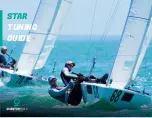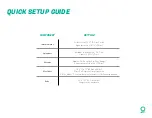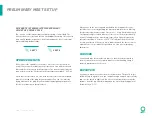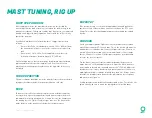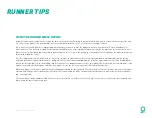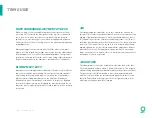
S TA R / T UNIN G GUIDE
MAST STEP AND RAM
After stepping the mast, the mast butt location can be checked by
measuring from the back of the mast, just above the butt casting, to the
plane of the transom. To help you read the tape measure, we recommend
putting a non-tapered, heavy top batten (comes with the sail) vertically
against the transom.
If you have a new boat, start with the builder’s suggested mast step
location.
• On the older Follis, the standard location is 14’ 9¼“ (450cm) from
the transom-deck intersection to the center of the aft mast step
bolt.
• On the newer Follis, Lillia, P-star and Mader, the mast step
location will be more forward, up to 14’ 11” (455cm).
Pull on enough ram so that the mast pops forward into a positive bend
position and then take the ram completely off. If the ram is still on
when you’re measuring the shroud tension, the rig will be incorrectly
tensioned.
SHROUD POSITION
The lower shrouds should be set in line with the front of the mast. Attach
the upper shrouds to the deck in equal positions on each side.
RAKE
To measure the rake, start with the tape measure at the bottom of the
forestay where it goes through the deck, and measure up to the mark
you made when the rig was down. On a longer forestay, the number you
are looking for is 36” (94cm). To adjust your rake, use the stay master
under the deck or the purchase at the back of the barney post.
MAST TUNING, RIG UP
BACKSTAY
Take your backstays, set them in the upwind position, and pull on the
purchase evenly so that each has 5 units of tension on the PT-1 Loos
Gauge. This is the best starting point to move on to tuning the shroud
tension.
SHROUDS
Check your upper shrouds. Tighten or loosen them until they read 24
units of tension on the PT-1 Loos Gauge. This is the tension you want for
medium breeze conditions of 8-12 knots. In lighter breezes, 23 units of
tension allows the mast and sails to retain more power. In a stronger
breeze, 25 units of tension will help reduce the power of the boat and
increase the level of control.
For the lowers, measure from the top of the band at the gooseneck
up the mast 36” (91.5cm) and make a mark. From this mark, measure
from shroud to shroud, which should measure 29” (73.5cm). Adjust the
turnbuckles if necessary. Another way to quickly measure tension is to
hand-tighten the lower shrouds fully and then back off 1.5 turns. Lower
shrouds can be adjusted for power needs; pull them on for less power
and off to increase power.
Setting shroud tension be difficult to understand at first. To reinforce our
points visually, be sure to watch the tuning videos in the link above.
Содержание STAR
Страница 1: ...STAR TUNING GUIDE ...

